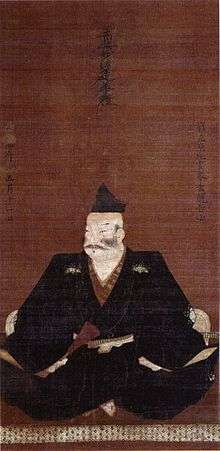Saitō Yoshitatsu
Saitō Yoshitatsu (斎藤 義龍, 8 July 1527 – 23 June 1561) was a Japanese samurai during the Sengoku period.[1]

Yoshitatsu was the son of Saitō Dōsan, however, rumors that Yoshitatsu was in fact not Dosan's real son (that is, that he was actually Yorinari's son) persisted and Dôsan apparently began to think of naming one of his other sons, Nagatatsu, as heir. Yoshitatsu had come to suspect his father's intentions. Though he actually did suffer from leprosy, Yoshitatsu feigned illness and murdered his two younger brothers in 1555 and declared war on Dosan. In May 1556 Yoshitatsu led an army to the Nagaragawa river, prompting Dosan to take up a position on the opposite side of the river. Yoshitatsu's vanguard opened the attack by crossing the river and cutting deeply into Dosan's ranks. They nearly reached Dosan's headquarters before being savaged by a counterattack. Yoshitatsu then led the bulk of his forces across the river and in the course of the fighting Dosan was killed. Yoshitatsu thereafter assumed control of Mino. He proved a capable commander and was able to defeat attempts by Oda Nobunaga to avenge Dôsan's death, but died of his illness in 1561.
Yoshitatsu's son, Saitō Tatsuoki, was defeated by Oda Nobunaga in 1567 at the Siege of Inabayama; and the clan disappeared.[1]
See also
- Battle of Nagaragawa
References
- Papinot, Jacques Edmond Joseph. (1906). Dictionnaire d’histoire et de géographie du Japon; Papinot, (2003). "Saitō," Nobiliare du Japon, p. 50 [PDF 54 of 80]; retrieved 2013-4-30.
External links